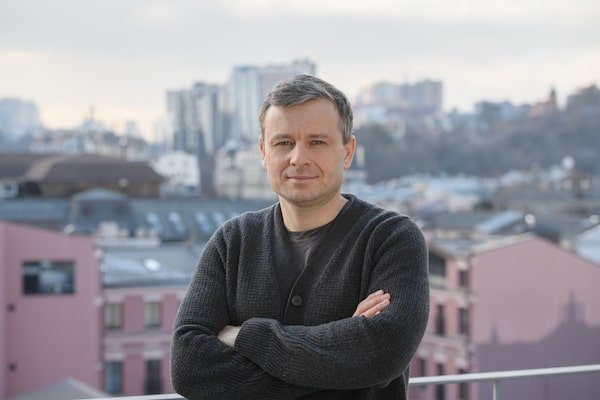
Ukrainian Finance Minister Sergii Marchenko at the Ministry of Finance offices, on Jan. 29.Olga Ivashchenko/The Globe and Mail/The Globe and Mail
Ukrainian Finance Minister Sergii Marchenko seemed genuinely afraid that his country was on the verge of financial disaster when I interviewed him almost three weeks ago. In Washington and in Brussels, political infighting was preventing the equivalent of more than U$100-billion in assistance from reaching Kyiv. He was preparing an emergency budget to keep the financial show going if the money did not arrive. “We need additional military and financial support,” he said. “It’s a question of survival.”
A few days later, Viktor Orban, the Russia-friendly Hungarian Prime Minister who had been blocking the European Union’s effort to hand €50-billion to the Ukrainian government, signed off on the deal after European leaders read the riot act to him. Mr. Marchenko was relieved.
Washington next? He hoped so. But by the end of this week, the bipartisan bill in Congress that would have delivered some US$60-billion to Ukraine in exchange for a clampdown on migrants along the U.S.-Mexico border had collapsed. President Joe Biden blamed Donald Trump for convincing Republican lawmakers to kill the package. Mr. Biden was enraged. “A failure to support Ukraine at this critical moment will never be forgotten,” he said.
We in the West sometimes forget that two wars are under way in Ukraine – the fighting war and the financial war. The former gets most of the headlines. Readers are absorbed, often shocked, by the battle stories, the tales of horror and heroism, the advanced weapons such as the Ukrainian naval drones that sink Russian warships and the distressing images of shredded cities.
The money side – the foreign donations needed to fill the deep budget hole, as Kyiv funnels almost all its tax revenue to the military – gets far less attention.
According to Mr. Marchenko, last year’s external financing was US$42.5-billion. This year, he will need to find U$37.3-billion. Unless his Finance Ministry gets that amount, or close to it, he may find himself implementing savage budget cuts, which would jeopardize pensions and government salaries, and unleashing another round of monetary financing – printing money – that might trigger hyperinflation (in 2022, the first year of the war, inflation hit 26 per cent).
In short, Ukraine needs more funding – and fast – to build on its success. Anyone who follows the war might ask: Is Ukraine still succeeding?
They would point to the much-hyped counteroffensive that began last summer and went pretty much nowhere, at great cost; the renewed assaults in the east by well-armed Russian soldiers with a 5-to-1 or 10-to-1 ammunition advantage; the high-level internal divisions that, for instance, pitted Ukrainian President Volodymyr Zelensky against his popular top military commander, Valery Zaluzhny, who was fired Thursday evening.
All true, but Ukraine’s successes have been compelling, even astounding.
Here is a country with a third of Russia’s population that managed to repel one of the world’s biggest armies. A war that was to end in one week with Russian troops marching through Kyiv is now entering its third year, as the Kremlin’s victory plans turn to rubble. Ukraine’s military, with essentially no navy and a tiny air force, has pushed Russian warships to the eastern side of the Black Sea. Ukraine is launching drone attacks deep inside Russia and becoming largely self-sufficient in those weapons. The economy is not only remarkably intact but expanding again. And grain exports, which had all but stopped in the first few months of the war, are rebounding as Ukraine reopens shipping corridors in the Black Sea.
But instead of helping Ukraine build on this success, the West – the United States, Canada, the EU and a few smaller allies – is being stingy after an early bout of generosity. Yes, the EU just gave €50-billion to Ukraine, but the amount is spread over four years. The next American aid package is stuck in the chaos of the petty battlefield of Congress. The flow of weapons is too small to allow the Ukrainian military to make gains on the battlefield; a severe shortage of 155 mm shells is forcing Ukrainian artillery crews to ration ammunition.
On Thursday, Polish Prime Minister Donald Tusk delivered a sharp rebuke to U.S. Republicans for blocking Ukraine’s aid package. “Ronald Reagan, who helped millions of us win back our freedom and independence, must be turning in his grave today. Shame on you,” he wrote on social media.
Providing Ukraine with financial assistance to keep its economy alive and procure enough arms to regain lost territory, not just defend what it hasn’t lost, is not just a moral imperative for the West as Russian President Vladimir Putin apparently attempts to rebuild the Soviet empire. It is, by most accounts, a bargain.
Various reports say the amounts pledged to Kyiv this year amount to less than 0.25 per cent of the collective GDP of the EU, the United States and the U.K. – the three biggest donors since the start of the invasion two years ago. The amount is relatively insignificant. The European Commission said energy subsidies alone in the EU came to 1.2 per cent of GDP in 2020.
Ukraine is not losing the war, but its territorial gains in the past year were meagre. The economy is in far better shape than it was in 2022 but is still a quarter smaller than it was before the invasion. Ukraine needs to build on its military and economic successes. A lack of continued external support could reverse all its gains in a hurry, crashing the economy and giving an even greater military advantage to Russia. Penny-pinching by the West could hand Mr. Putin a huge gift.